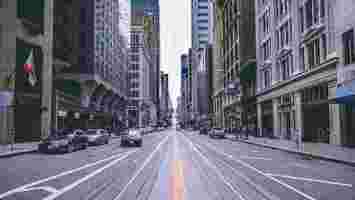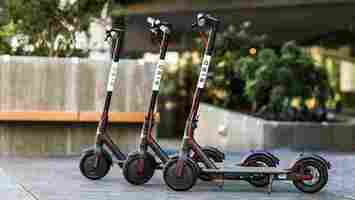Why cities must narrow car lanes to make room for pedestrians
Close your eyes and imagine a typical city street. What do you see?

For most of us it’s a variation of a familiar scene: two lanes of automobile traffic most likely flanked by a row of densely parked cars on either side. Confined to the periphery, narrow sidewalks accommodate the vast majority of human activity performed by pedestrians, joggers, tourists, commuters, parents, pet owners, municipal workers, and street vendors.
These are the city streets much of the world has come to know and accept over the past 100 years as urban living has progressively become defined by smog, combustion engines and tens of millions of square meters of car parking . It’s time for that to end.
The post-pandemic 21st century is emerging as the era of the Third Lane—an innovative new way to use public space that disrupts our conventional, bidirectional norms.
Of course, on its surface the concept appears straightforward. By eliminating car parking and narrowing automobile lanes we can create the space necessary to accommodate lightweight, human sized micromobility vehicles such as electric scooters.
Once you better understand its implications, however, the Third Lane takes on a new level of significance that redefines the way we understand cities and urban public space altogether.
The Third Lane and increased mobility
For one, the Third Lane represents the freedom of physical mobility. We’ve long known that bikes and scooters—vehicles built to human scale—travel faster through cities than cars and motorcycles . They’re lighter, nimbler and more streamlined, making them significantly less susceptible to the traffic congestion that’s become so prevalent on city streets. They’re also much easier to park.
Protected micromobility infrastructure increases these advantages by safely separating the large and cumbersome vehicles from the small and agile ones. When cities prioritize the Third Lane, they’re investing in increased freedom of movement at a speed and scale designed for compact urban environments.
The Third Lane and economic opportunity
Prioritizing the Third Lane does more than just improve mobility, however. It also benefits local economies and small businesses in a number of ways, the first of which being perhaps the most evident.
Micromobility riders frequently travel to and from local shops and restaurants. We know this because, at Bird, approximately 50% of our riders surveyed indicated that the purpose of their most recent trip was dining or shopping. Moreover, more than 70% of those riders said that they were more likely to visit the establishment because of Bird. We see this trend consistently in cities around the world: when there are Birds outside, there are customers inside.
In conjunction with micromobility services, the Third Lane also connects riders to employment opportunities. It does this not only by increasing the accessibility of public transit stops, but by providing new mobility options and safe, expedient travel routes in areas traditionally underserved by public transit altogether. Researchers in Chicago, for example, found that e-scooters gave individuals access to 16% more jobs within a 30 minute radius compared to walking or transit alone. In Miami, a similar study found that 40% more jobs were reachable without lengthening current commute times thanks to micromobility.
Perhaps the most interesting way the Third Lane impacts local economies, however, has nothing to do with the lane itself. Instead, it’s connected to the same guiding principle of reclaiming public space . As we’ve seen in cities from San Francisco to Marseille, policy makers are repurposing streets and sidewalks in response to COVID-19, allowing restaurant patrons ample room to properly social distance. The results have been almost universally lauded as joyless parking spaces have been converted into lively centers of commerce and entertainment.
The Third Lane is an invitation to rethink urban streets, taking them away from cars and giving them back to the people and businesses that give life to our cities.
The Third Lane and social equity
Beyond efficiencies and economics, however, the Third Lane’s most prolific benefit is its inherent potential to promote social equity. We’ve already discussed how safe access to jobs and public transit increase when micromobility services and infrastructure are in place—but there’s more to it than that.
Car ownership, particularly in the US, is still closely connected to income . In general, the more money you make, the more likely you are to own a car (or two). Thus city streets dedicated solely to automobile traffic and car parking only serve to further isolate low-income neighborhoods and underserved populations. That can no longer be tolerated.
A recent study published in Transportation Research: Part A found that not only are electric scooters used more for transportation than for recreation, but they’re significantly more appealing to new riders who identify as non-white as well. That’s an encouraging start, and it highlights the potential for e-scooters not only to appeal to a wider swath of the population but to help level the urban mobility playing field for everyone. The only critical component missing is a protected, prioritized Third Lane in which to ride them.
For these reasons, and many more, it’s imperative that cities use the current health crisis as an opportunity to rethink conventional mobility norms and reclaim valuable urban street space. As the era of car dominated cities takes its inevitable place in the rear view mirror, the future of sustainable, equitable urban transportation is moving decisively into the Third Lane.
This article was written by Travis Vander Zanden, Founder & CEO, Bird , on The Urban Mobility Daily , the content site of the Urban Mobility Company, a Paris-based company which is moving the business of mobility forward through physical and virtual events and services. Join their community of 10K+ global mobility professionals by signing up for the Urban Mobility Weekly newsletter . Read the original article here and follow them on Linkedin and Twitter .
SHIFT is brought to you by Polestar. It’s time to accelerate the shift to sustainable mobility. That is why Polestar combines electric driving with cutting-edge design and thrilling performance. Find out how .
Where the good goddamn are the bikes at COP26?
Among all the posturing and grandstanding about climate change, you’ll see something that’s noticeably absent at COP26 in Glasgow this week — cycling.

I saw a tweet this morning (I love Twitter), and it asked an excellent question:
Seriously, where are all the bikes and ebikes? How about some cargo bikes — they could be used to tow a few politicians far better than car cavalcades.
For transport, used by most of the world’s population, the absence of cycling in any official capacity is at best laughable and, at worst, downright negligent.
For a greener future GET MORE PEOPLE CYCLING
This week a global coalition of over 60 bicycle organizations, including the European Cyclists Federation and the World Cycling Alliance , penned an open letter to the COP26 attendees. It offers a clear message: if you want to get serious about fighting the climate crisis, get more people on bicycles and do it now.
As the letter states:
Time for governments to put cycling first


The letter calls for a range of policy, funding, and public health actions. These include:
Creating and financing national cycling strategies and collecting data on cycling to guide infrastructural improvements.
Focusing investments on building safe and high-quality cycling infrastructure. This includes incentives for communities historically marginalized from cycling.
Providing direct incentives for people and businesses to switch from automobiles to bicycles for more of their daily trips.
Building synergies with public transport and foster combined mobility solutions for a multimodal ecosystem capable of covering all user needs without relying on a private car.
We’ve seen an acceleration of pro-ebike laws and funding proposals in the US. Still, for cycling to go mainstream, it needs to address why people prefer cars over bicycles — including issues of safety and road quality.
A survey by Good Ordering a couple of years ago found that the perception of unsafe roads and concerns around bike parking and security are two of the biggest reasons people avoid cycling — and it’s up to governments to act.
Let’s not forget the most basic form of transport — walking
However, if we’re talking about roads, I’d also like to see some attention turned to the plain old act of walking.
There are many cities without sidewalks or where broken concrete and potholes make it an obstacle course. It’s even worse when you are visually impaired or use a mobility aid.
Then, there are poorly lit streets that make walking at night unsafe — especially for women.
When I was in Amsterdam recently, I had to get a PCR test for my next leg of travel. As there was no public transport option between the clinic and the conference venue, I thought I’d walk.
It was a lovely day, and I had plenty of time. I started walking the route suggested by Google Maps only to find it directed me to an overpass bridge that had car and bicycle lanes but no lane for walking. And I can’t walk through a canal!
I ended up getting a Bolt. The driver told me this was a common problem for tourists and visitors unfamiliar with the city’s layout. God forbid we want to take the fastest route too on foot.
Getting people out of their cars — even just some of the time — is a pretty radical act when you think about the money machine that is the auto industry. But cycling is a win for all in terms of health, air quality, and reducing CO2 emissions.
But, it just takes leadership and even more, follow-through, something I’m not convinced we’ll see all that much of at COP26.
Chicago’s second escooter trial shows riders are losing interest
This article was originally published by Christopher Carey on Cities Today , the leading news platform on urban mobility and innovation, reaching an international audience of city leaders. For the latest updates follow Cities Today on Twitter , Facebook , LinkedIn , Instagram , and YouTube , or sign up for Cities Today News.

Chicago’s second e-scooter trial concluded last week, with the city seeing a 22% drop in ridership compared to last year’s four-month trial.
In total, 640,000 trips were provided between 12 August and 12 December by Bird, Lime , and Spin, the three firms participating in the trial.
During the initial four-month pilot that ran from 15 June to 15 October last year, riders took 821,000 trips in an area a quarter the size and with a quarter of the devices provided in the 2020 pilot, according to the Chicago Department of Transportation (CDOT) .
Speaking about the drop in numbers, Sara Dodrill, Communications Manager, Spin told Cities Today : “The pandemic prompted multiple stay-at-home orders across Chicago over the course of 2020. As a result, the use of transportation has been down across all modes of transit, not just e-scooters.
“Another major difference between the 2019 pilot and the 2020 pilot is the time of year when the pilot was executed. The 2019 pilot was carried out during peak season for e-scooter transit, mid-June to mid-October. The 2020 pilot was delayed because of the pandemic and missed two of our highest ridership months.”
In addition to this, CDOT also expanded its Divvy bike scheme in the Far South Side neighborhood in August with the introduction of 3,000 new e-bikes.
Despite the reduction in numbers, the city says changes in the second pilot have reduced pavement clutter caused by improper parking, lowered the number of resident complaints, and increased access to shared e-scooters in equity priority areas on the South and West Sides.
The average trip length was also longer, up 14% on the previous year, and the city is now seeking feedback from members of the public through an online survey that runs until 7 January.
“Now that the second pilot is winding down, we invite the public to share their feedback and help us evaluate whether e-scooters make sense as a permanent part of Chicago’s transportation system,” Gia Biagi, CDOT Commissioner, said.
“We want to hear from everyone, whether they were a scooter user or not. It’s important that we incorporate feedback from all across the city in our decision-making as we go forward.”
Equity
One of the primary questions the city wanted to explore in the 2020 pilot was whether e-scooters could effectively improve mobility for residents who face economic, health, mobility, or accessibility barriers, with officials saying these issues took on added significance due to the transportation challenges posed by the COVID-19 crisis.
The city designated an equity priority area that included large portions of the South and West Sides, with each e-scooter vendor required to deploy 50% of their devices every day in priority areas.
Preliminary data revealed that on average, 52% of all devices were deployed to the areas, and each vendor’s average daily deployment actually exceeded the requirement.
This contrasted sharply with vendor compliance in 2019, when firms deployed just 36% of e-scooters to priority zones.
In total, almost 160,000 rides – about a quarter of trips – took place in the equity priority area on the South and West Sides.
Parking compliance
Another objective for the 2020 pilot was the reduction of improper parking of e-scooters on sidewalks, with special regard for keeping a safe path of travel for residents with disabilities.
To address the challenge, Chicago required that all e-scooters be equipped with a lock and secured to a fixed object to end a ride.
Initial stakeholder feedback and data indicated that e-scooter parking compliance improved significantly in the 2020 pilot, with a 79 percent decrease in complaints-per-day-per-device when compared to 2019.
“We are encouraged by the preliminary data we have seen from the second pilot,” Rosa Escareño, Business Affairs, and Consumer Protection Commissioner said.
“This pilot was designed thoughtfully and carefully to test this new mobility option, and we are now going to work with stakeholders to thoroughly examine the data to evaluate whether e-scooters make sense for Chicago in the long term.”
SHIFT is brought to you by Polestar. It’s time to accelerate the shift to sustainable mobility. That is why Polestar combines electric driving with cutting-edge design and thrilling performance. Find out how .